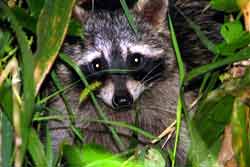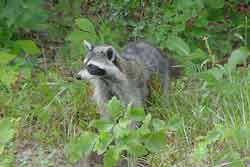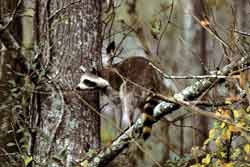Home → Pests → Other Critters → Raccoons
Raccoon—Procyon lotor
Raccoons are mammals; they are found in riparian areas along streams, lakes, marshes, swamps, farmland, and in suburban neighborhoods and in urban areas where they can find adequate food, water, and shelter. The raccoon is omnivorous which means they eat both plants and animals. Their diet is very broad, consisting of aquatic animals, fruits, nuts, cultivated crops and grains, birdseed, bird eggs, small mammals, birds, and garbage.
Raccoons can be pests by damaging vegetable gardens and crops, by killing poultry, by damaging houses and outbuildings and by raiding garbage cans in search of food.
Before trapping and releasing a wild animal in Maine an Animal Damage Control License must be obtained through Maine Inland Fisheries & Wildlife. They may be contacted via 207-287-8000.

Raccoons have a distinctive black robber's mask across the eyes and black banded tail. The remainder of their body's fur is a grizzly, grayish-brown.
Click on images to view full-size
Identification and Control Information
- Raccoons—Maine Department of Inland Fisheries & Wildlife
- Vermont Wildlife Fact Sheet: Raccoon (PDF)—Vermont Fish & Wildlife
- Raccoon Ecology and Damage Management (PDF)—Cooperative Extension of the University of Wisconsin-Extension
- Wildlife Damage Management Fact Sheet Series: Raccoons (PDF)—Cornell Cooperative Extension
- Prevention and Control of Wildlife Damage: Raccoons (PDF)—Internet Center for Wildlife Damage Management
More Information
- Dealing with Nuisance Wildlife (PDF)—University of Maryland Cooperative Extension
[Photos, left to right: Kevin D. Arvin, Bugwood.org; Ricky Layson, Ricky Layson Photography, Bugwood.org; Gerald J. Lenhard, Louisiana State Univ, Bugwood.org]

